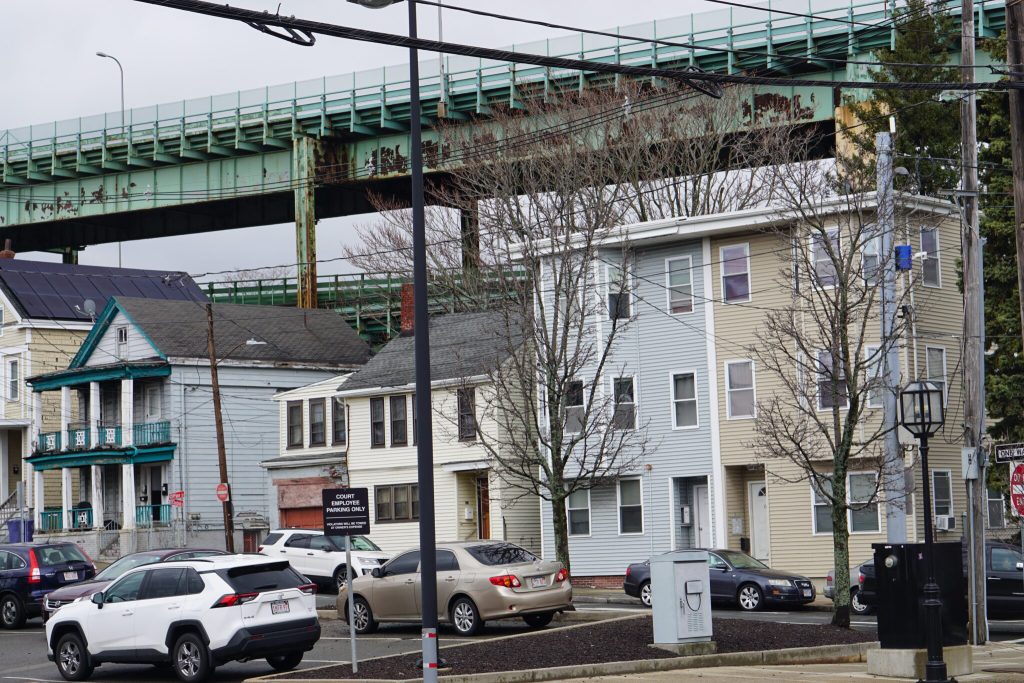MORE THAN A year after Chelsea residents sounded the alarm over lead paint chips falling from Tobin Bridge, the state has stepped in with a new mitigation plan to help address the problem, but some residents and environmental advocates say it’s not enough.
In February of 2023, residents raised concerns about paint chips falling from the bridge, which opened in 1950 and spans the Mystic River from Boston to Chelsea, a densely-packed low-income city of 40,000 people.
Lead paint can pose serious health risks – ingestion of chips or the dust it can give off is linked to neurological problems, kidney damage, and reproductive issues in adults. Lead poisoning is especially dangerous to children, in whom it can cause behavioral problems, learning disabilities, and, in extreme cases, even death.
The Massachusetts Department of Transportation, which owns and operates the Tobin Bridge, is working on a four-year project to repaint and make structural repairs to the bridge. In the fall of 2023, protective netting was installed to capture any paint chips that fall through during the project’s duration. MassDOT also initiated a cleanup to pick up fallen paint debris through a professional contracted service.
In a new effort to address concerns with dust and noise from the ongoing project to repaint the bridge and do structural repairs, MassDOT recently announced it will provide Chelsea residents who live within a certain distance of the bridge with air conditioners, air purifiers, an air-filter-equipped vacuum cleaner, and white noise machines.
Roseann Bongiovanni, executive director of GreenRoots, a Chelsea-based environmental justice organization, says the new initiative doesn’t get at the broader issue of the lead contamination from the bridge, including lead making its way into the soil.
“It’s not timely. It’s not appropriate for a number of different reasons,” Bongiovanni said. “The Tobin Bridge was essentially pouring lead paint into our backyards, our neighborhoods, our daycares, our playground, our businesses, our streets.These devices aren’t addressing the heart of the matter that families could have been poisoned by lead paint.”
MassDOT handed out appliances to more than 150 residents who came to pick up equipment at a Chelsea site on Wednesday, the first day of the new initiative, according to an email Bongiovanni received from MassDOT.
Tony Hernandez, a Chelsea resident who was the first to flag the issue of lead paint coming off the Tobin Bridge, echoed Bongiovanni’s disappointment with the mitigation plan.
“That’s a waste of money,” he said. “Whatever they give to them isn’t enough anyway.”
He also questioned the timing of distributing air conditioners the week before Labor Day. “Why are they giving it now? It’s the end of the summer,” he said.
Hernandez pointed to the fact that lead remains in the soil in backyards, parks, and neighborhoods for years after contamination. He wants the state to do soil testing in the areas near the bridge and replace it if it’s contaminated.
“There have been years and years of contaminated soil and my neighbors in Chelsea deserve better,” said Hernandez.
In a letter to Transportation Secretary Monica Tibbits-Nutt, Bongiovanni accused MassDOT of not seeking community input from residents and environmental groups like GreenRoots in coming up with a mitigation plan.
A MassDOT spokesperson pushed back, insisting in a statement that the agency has “worked closely with the City of Chelsea, its residents, and other key stakeholders in and around the community to address concerns about the ongoing Tobin Bridge repair project and falling paint chips from the bridge.”
Local advocates say many residents may not even be aware of the new mitigation program, but MassDOT said community groups and local officials were notified of the plan and flyers were distributed to the roughly 800 residential and commercial addresses within the construction zone in the days before the first scheduled appliance pick-up day.
“I know there are a lot of people who won’t hear about this or won’t have the time or ability to get to a pickup site,” said Sharlene McLean, a long-time Chelsea resident who lives one block from the bridge and is eligible for the program but only heard about it through a Facebook chat. “A lot more work needs to be done so that every property and every person is properly taken care of.”
Bongiovanni says MassDOT needs to do more to address the problems that could be caused by the bridge project, including sending people door to door to offer blood lead level testing and paying for lead poisoning-associated health care costs. MassDOT recommends to concerned parents that young children be tested for lead exposure at their next well-child visit.
As with other disadvantaged communities, Chelsea – a low-income, majority Hispanic city – has had to contend with a long series of environmental hazards.
Before the recent problem of lead paint falling from the Tobin Bridge, in 2020, amid the COVID-19 pandemic, dust from a construction project on Route 1 and the Tobin Bridge covered big swaths of the city in dust and rattled residents with construction going through the night. In 2022, asbestos was found in construction debris that piled up next to a public housing complex.
The problems underscore Chelsea’s status as a heavily burdened “environmental justice population,” a state designation for communities that have low household income, where minority group members account for 40 percent or more of the population, or where at least a quarter of the households lack strong English language skills.
“Chelsea is an immigrant community. It’s an environmental justice community,” said Hernandez. “Shit like this doesn’t happen in Newton. It doesn’t happen there. It happens here. Nobody cares. They don’t prevent stuff from happening.”
The post Chelsea residents angry over handling of Tobin Bridge construction project appeared first on CommonWealth Beacon.

